
|
oxytetracycline |
oxytetracycline is a lipid of Polyketides (PK) class. Oxytetracycline is associated with abnormalities such as Infection, X-linked centronuclear myopathy, Bacterial Infections, Heart failure and Onchocerciasis. The involved functions are known as Anabolism, physiological aspects, Transcription, Genetic, Fermentation and Transcriptional Activation. Oxytetracycline often locates in Chromosomes, Flank (surface region), Entire bony skeleton, Bone Marrow and Body tissue. The associated genes with oxytetracycline are Polypeptides, Homologous Gene, Gene Clusters, Locus and CYCS gene. The related lipids are LH 1 and Lipid Peroxides. The related experimental models are Disease model. |
6787 |

|
erythromycin |
erythromycin is a lipid of Polyketides (PK) class. Erythromycin is associated with abnormalities such as Systemic Inflammatory Response Syndrome, Pneumonia, Infection, Pneumococcal Infections and Exanthema. The involved functions are known as Pharmacodynamics, Sterility, Agent, Drug Kinetics and Adjudication. Erythromycin often locates in Blood, peritoneal, Extracellular, Ribosomes and apicoplast. The associated genes with erythromycin are P4HTM gene, SLC33A1 gene, FAM3B gene, Operon and Homologous Gene. The related lipids are Hydroxytestosterones, Steroids, Propionate, Mycolic Acids and campesterol. The related experimental models are Mouse Model and Knock-out. |
19871 |

|
Azithramycine |
Azithramycine is a lipid of Polyketides (PK) class. Azithramycine is associated with abnormalities such as Respiratory Tract Infections, Pneumonia, Lower respiratory tract infection, Infection and Nonspecific urethritis. The involved functions are known as Lysis, Selection, Genetic, Mutation, Relapse and Adaptation. Azithramycine often locates in Blood, Respiratory System, Genitourinary system, Back and Chest. The associated genes with Azithramycine are Genes, rRNA, Genome, RPL22 gene, OPRM1 gene and tryptic soy broth. The related lipids are Liposomes, Phosphatidylserines, Promega, Lipopolysaccharides and Steroids. The related experimental models are Mouse Model, Knock-out and Tissue Model. |
7835 |

|
oleandomycin |
oleandomycin is a lipid of Polyketides (PK) class. The involved functions are known as 5-(carboxyamino)imidazole ribonucleotide mutase activity, Methylation, enzyme activity, Anabolism and Biosynthetic Pathways. Oleandomycin often locates in Chromosomes and Protoplasm. The associated genes with oleandomycin are resistance genes, Open Reading Frames, CTTNBP2 gene, Gene Feature and Gene Clusters. |
811 |

|
clarithromycin |
clarithromycin is a lipid of Polyketides (PK) class. Clarithromycin is associated with abnormalities such as Helicobacter Pylori Infection, Infection, Coinfection, Gastritis and Peptic Ulcer. The involved functions are known as Point Mutation, Increased Sensitivy, Bacterial resistance, urease activity and Mutation. Clarithromycin often locates in Blood, Gastric mucosa, Biopsy sample, Respiratory System and Entire gastrointestinal tract. The associated genes with clarithromycin are Genes, rRNA, rRNA Operon, Genome, HM13 gene and GDF15 gene. The related lipids are 9,11-linoleic acid, Steroids, Lysophosphatidylcholines, Lipopolysaccharides and 4-hydroxycholesterol. The related experimental models are Mouse Model, Knock-out and Experimental Pneumococcal Meningitis. |
10449 |

|
ZEARALENONE |
ZEARALENONE is a lipid of Polyketides (PK) class. Zearalenone is associated with abnormalities such as HYPOTRICHOSIS, LOCALIZED, AUTOSOMAL RECESSIVE, 2, Estrogen excess, Food-Drug Interactions, Osteomalacia and Osteoporosis. The involved functions are known as mRNA Expression, Metabolic Inhibition, Phosphorylation, Agent and Transcriptional Activation. Zearalenone often locates in Gastrointestinal tract structure, soluble, viral nucleocapsid location, Spindle and Hepatic. The associated genes with ZEARALENONE are Candidate Disease Gene, Genome, Genes, Reporter, P4HTM gene and Open Reading Frames. The related lipids are Lipopolysaccharides, Steroids, Fatty Acids and Promega. The related experimental models are Transgenic Model. |
2573 |
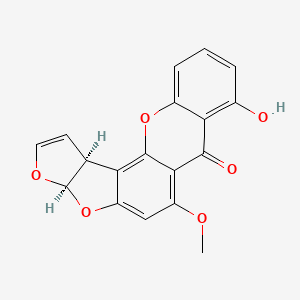
|
STERIGMATOCYSTIN |
STERIGMATOCYSTIN is a lipid of Polyketides (PK) class. Sterigmatocystin is associated with abnormalities such as CLEFT LIP, CONGENITAL HEALED, Exanthema and Lung diseases. The involved functions are known as sterigmatocystin biosynthetic process, Signal, secondary metabolic process, Biosynthetic Pathways and Anabolism. Sterigmatocystin often locates in Genital system, SAGA complex, Chromosomes, germ tube and Extracellular. The associated genes with STERIGMATOCYSTIN are Genome, Genes, vif, Homologous Gene, Genes, Regulator and Gene Clusters. The related lipids are hexanoic acid, Fatty Acids and Fatty Acids, Unsaturated. |
891 |
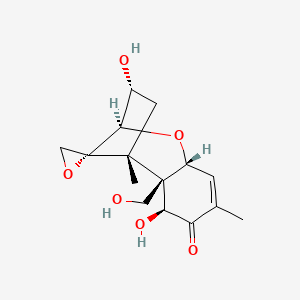
|
Vomitoxin |
Vomitoxin is a lipid of Prenol Lipids (PR) class. Vomitoxin is associated with abnormalities such as Infection and Gastroenteritis. The involved functions are known as mRNA Expression, Inflammation, Transcription, Genetic, Protein Biosynthesis and Adverse effects. Vomitoxin often locates in Lymphoid Tissue, Immune system, Bone Marrow and Plasma membrane. The associated genes with Vomitoxin are IMPACT gene, HIST1H1C gene and RBM39 gene. The related experimental models are Mouse Model. |
2643 |
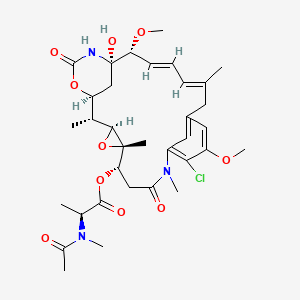
|
MAYTANSINE |
MAYTANSINE is a lipid of Polyketides (PK) class. Maytansine is associated with abnormalities such as Myelosuppression and BOSLEY-SALIH-ALORAINY SYNDROME. The involved functions are known as Mutation, Agent, Polymerization, Cell Cycle Arrest and Drug Kinetics. Maytansine often locates in Cytoplasm, Hepatic, Lysosomes, Cell surface and Microtubules. The associated genes with MAYTANSINE are ABCB1 gene, HM13 gene, CNN1 gene, CYP2C8 gene and CYP2D6 gene. The related lipids are Valerates. The related experimental models are Xenograft Model. |
984 |
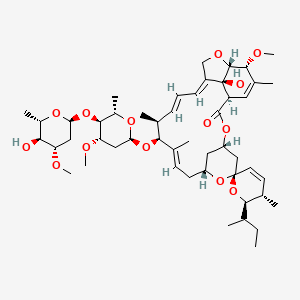
|
Avermectin A1a |
Avermectin A1a is a lipid of Polyketides (PK) class. Avermectin a1a is associated with abnormalities such as Ataxia with vitamin E deficiency, Strongyloidiasis, Congenital Transposition, Gigantism and Onchocerciasis. The involved functions are known as DNA Binding, Anabolism, Insertion Mutation, Process and physiological aspects. Avermectin a1a often locates in Chromosomes, Membrane, Clone, soluble and Tissue membrane. The associated genes with Avermectin A1a are Polypeptides, oxytocin, 1-desamino-(O-Et-Tyr)(2)-, Gene Feature, Genome and Gene Clusters. The related lipids are Propionate. The related experimental models are Mouse Model. |
765 |
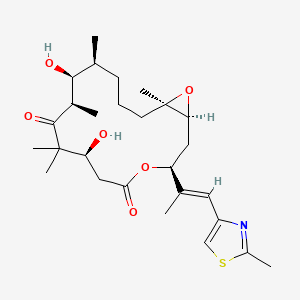
|
Epothilone B |
Epothilone B is a lipid of Polyketides (PK) class. Epothilone b is associated with abnormalities such as Myelosuppression, Measurable Disease, Neuropathy, Neutropenia and Thrombocytopenia. The involved functions are known as Cell Cycle Arrest, Apoptosis, Signal Transduction, Cytokinesis and Caspase Activation. Epothilone b often locates in Mitochondria, Cytoplasmic matrix, Microtubules, Spindle and Protoplasm. The associated genes with Epothilone B are TNFSF10 gene, DIABLO gene, FADD gene, BCL2 gene and BCL2L1 gene. The related lipids are Promega and Phosphatidylserines. The related experimental models are Xenograft Model and Mouse Model. |
492 |
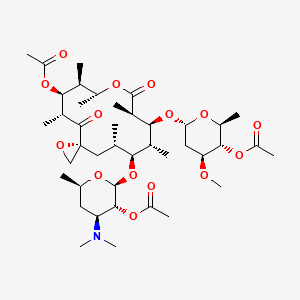
|
TROLEANDOMYCIN |
TROLEANDOMYCIN is a lipid of Polyketides (PK) class. Troleandomycin is associated with abnormalities such as Xanthomatosis, Cerebrotendinous and Jaundice, Obstructive. The involved functions are known as Binding (Molecular Function), Anabolism, hydroxylase activity, Oxidation and immunoreactivity. Troleandomycin often locates in Microsomes, Liver, Human tissue, Microsomes, Hepatic and Immune system. The associated genes with TROLEANDOMYCIN are CYP3A5 gene, CYP3A7 gene, CYP2D6 gene, P4HTM gene and CYP2C19 gene. The related lipids are Androstenes, androstan-17-one, 25-hydroxycholesterol, Sterols and 4-hydroxycholesterol. |
948 |

|
nystatin |
nystatin is a lipid of Polyketides (PK) class. Nystatin is associated with abnormalities such as Virus Diseases, Infection, Candidiasis, Leukopenia and Mycoses. The involved functions are known as Membrane Potentials, Uptake, Flow or discharge, Cell membrane potential and adenine transport. Nystatin often locates in Cell Wall, Plasma membrane, Extracellular, Membrane and Virion. The associated genes with nystatin are Genome, Integral Membrane Proteins, Amino Acids, Basic, P4HTM gene and Homologous Gene. The related lipids are Sterols, Liposomes, Membrane Lipids, Sphingolipids and 1,2-oleoylphosphatidylcholine. The related experimental models are Knock-out and Xenograft Model. |
4890 |

|
Nystatin A3 |
Nystatin A3 is a lipid of Polyketides (PK) class. Nystatin a3 is associated with abnormalities such as Mycoses, Candidiasis of the genitals and Gigantism. The involved functions are known as Drug Interactions, Process, Synthesis, Fermentation and Anabolism. Nystatin a3 often locates in Cell membrane, Membrane, Protoplasm, Entire oral cavity and integral to membrane. The associated genes with Nystatin A3 are Gene Clusters. The related lipids are Sterols, 1,2-oleoylphosphatidylcholine, Membrane Lipids, DOPE and N-caproylsphingosine. |
2059 |

|
minocycline |
minocycline is a lipid of Polyketides (PK) class. Minocycline is associated with abnormalities such as Infection, Soft Tissue Infections, Septicemia, Chronic hyponatremia and Lesion of brain. The involved functions are known as Pharmacodynamics, Gene Expression, Transcriptional Activation, Regulation and Process. Minocycline often locates in Ribosomes, 50S ribosomal subunit, Blood, Skin and Immune system. The associated genes with minocycline are THEMIS gene, KCNK2 gene, RBFOX3 gene, PIWIL2 gene and P4HTM gene. The related lipids are Lipopolysaccharides, Promega, Steroids, Liposomes and Octanols. The related experimental models are Mouse Model, Experimental Autoimmune Encephalomyelitis, Genetically Engineered Mouse, Disease model and spinal model. |
9780 |
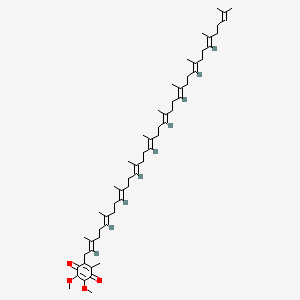
|
Coenzyme Q10 |
Coenzyme q10 is a lipid of Prenol Lipids (PR) class. Coenzyme q10 is associated with abnormalities such as Nephrotic Syndrome, Diabetes, COENZYME Q10 DEFICIENCY, Deafness and Hypertensive disease. The involved functions are known as Mutation, Process, Oxidation, Electron Transport and Oxidants. Coenzyme q10 often locates in Mitochondria, soluble, Plasma membrane, Body tissue and Inner mitochondrial membrane. The associated genes with Coenzyme Q10 are MT-CYB gene, ATP5B gene, cytochrome c'', STN gene and NPC1 gene. The related lipids are Total cholesterol and Lipid Peroxides. The related experimental models are Mouse Model. |
4537 |
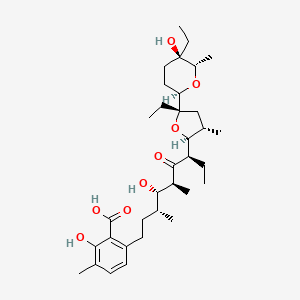
|
lasalocid |
Lasalocid a is a lipid of Polyketides (PK) class. |
1136 |
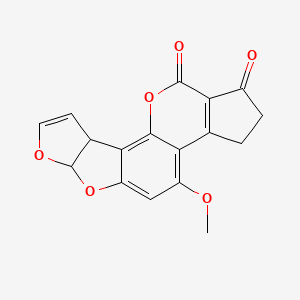
|
AFBI |
AFBI is a lipid of Polyketides (PK) class. Afbi is associated with abnormalities such as Pyotraumatic dermatitis, Infection, Hepatitis, Liver diseases and Hepatitis B. The involved functions are known as Immune response, Mutation, Anabolism, Metabolic Inhibition and Increased Sensitivy. Afbi often locates in Body tissue, Hepatic, Cytoplasm, Blood and Micronucleus. The associated genes with AFBI are TP53 gene, Genome, Transgenes, FATE1 gene and MANEA gene. The related lipids are Lipopolysaccharides, Lipid Peroxides, 1-(2-cyano-3,12-dioxooleana-1,9-dien-28-oyl) imidazole and Liposomes. |
5774 |

|
CYTOCHALASIN B |
CYTOCHALASIN B is a lipid of Polyketides (PK) class. Cytochalasin b is associated with abnormalities such as Renal tubular disorder and Chagas Disease. The involved functions are known as Membrane Protein Traffic, inhibitors, Metabolic Inhibition, Biochemical Pathway and Increased Sensitivy. Cytochalasin b often locates in Cytoplasmic matrix, Plasma membrane, Microtubules, Extracellular and Protoplasm. The associated genes with CYTOCHALASIN B are SLC2A2 gene, PFDN5 gene, SLC2A1 gene, OMG gene and SPEN gene. The related lipids are Steroids, Lipopolysaccharides and Liposomes. The related experimental models are Xenograft Model. |
9648 |
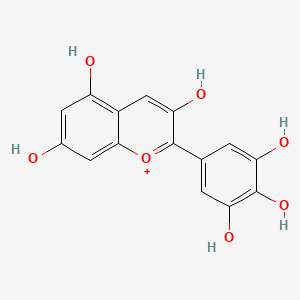
|
Delphinidin |
Delphinidin is a lipid of Polyketides (PK) class. Delphinidin is associated with abnormalities such as Virus Diseases, Chronic disease, Inflammatory disorder, Degenerative polyarthritis and Cardiovascular Diseases. The involved functions are known as Signal Pathways, Metabolic Inhibition, Signal Transduction, Cell Proliferation and Cell Death. Delphinidin often locates in Tissue membrane, Tubulo-reticular structure, Smooth muscle (tissue), Endothelium and soluble. The associated genes with Delphinidin are KDR gene, P4HTM gene, IRAK1 gene, MAPK14 wt Allele and ADAMTS3 gene. The related lipids are Steroids, Total cholesterol and saikosaponin B2. The related experimental models are Xenograft Model, Knock-out, Disease model and Animal Disease Models. |
727 |
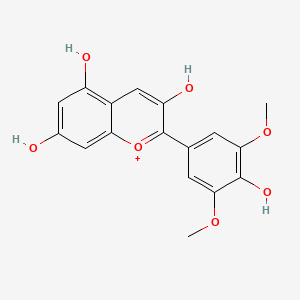
|
Malvidin |
Malvidin is a lipid of Polyketides (PK) class. The involved functions are known as conjugation. |
363 |
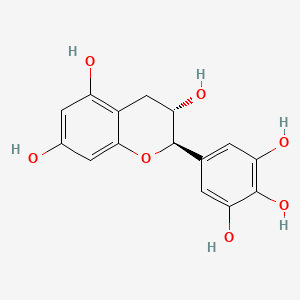
|
Gallocatechin |
(+)-gallocatechin is a lipid of Polyketides (PK) class. The involved functions are known as inhibitors and Cell Survival. The associated genes with (+)-Gallocatechin are TERT gene. |
778 |

|
(-)-Epicatechin gallate |
(-)-Epicatechin gallate is a lipid of Polyketides (PK) class. (-)-epicatechin gallate is associated with abnormalities such as Infection, trachomatis, Heart Diseases, Influenza and Hypoglycemia. The involved functions are known as Cell Proliferation, Metabolic Inhibition, Anabolism, protein expression and Apoptosis. (-)-epicatechin gallate often locates in Tissue membrane, Membrane, soluble, Plasma membrane and Protoplasm. The associated genes with (-)-Epicatechin gallate are GDF15 gene, ATF3 gene, CRISP2 gene, Homologous Gene and activating transcription factor 3. The related lipids are Lipopolysaccharides. The related experimental models are Cancer Model and Mouse Model. |
645 |
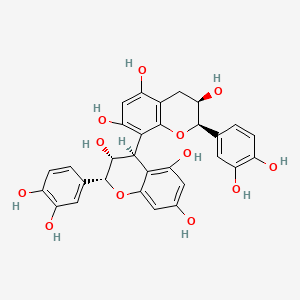
|
Procyanidin B2 |
Procyanidin B2 is a lipid of Polyketides (PK) class. The involved functions are known as conjugation, Methylation, Excretory function, enzyme activity and sulfatase activity. Procyanidin b2 often locates in Blood, Epidermis and Upper Gastrointestinal Tract. The associated genes with Procyanidin B2 are NR5A2 gene, HRAS wt Allele, CFB gene, PTGS2 gene and MAPK8 gene. |
205 |

|
(-)-Epigallocatechin gallate |
(-)-Epigallocatechin gallate is a lipid of Polyketides (PK) class. (-)-epigallocatechin gallate is associated with abnormalities such as IMMUNE SUPPRESSION, Infection, Nodule, Lymphopenia and Tumor Immunity. The involved functions are known as Apoptosis, Cellular Immune Response, Specific immune response, Signal and Infiltration. (-)-epigallocatechin gallate often locates in Immune system, Cytoplasmic Granules, Skin, Protoplasm and Body tissue. The associated genes with (-)-Epigallocatechin gallate are C8orf4 gene, Genes, vpr, MAPK8 gene, P4HTM gene and GAG Gene. The related lipids are Promega, Lipopolysaccharides, Palmitates, Fatty Acids and Sphingolipids. The related experimental models are Mouse Model, Xenograft Model, Transgenic Model, Experimental Autoimmune Encephalomyelitis and Arthritis, Collagen-Induced. |
6551 |

|
(-)-Epigallocatechin |
(-)-Epigallocatechin is a lipid of Polyketides (PK) class. The involved functions are known as Protective Agents, inhibitors, Process, Drug Kinetics and Fermentation. (-)-epigallocatechin often locates in Hepatic, Blood, Membrane, Back and apical membrane. The associated genes with (-)-Epigallocatechin are ADRBK1 gene and FASTK Gene. The related lipids are 1,2-dilinolenoyl-3-(4-aminobutyryl)propane-1,2,3-triol. The related experimental models are Rodent Model and Transgenic Model. |
1282 |
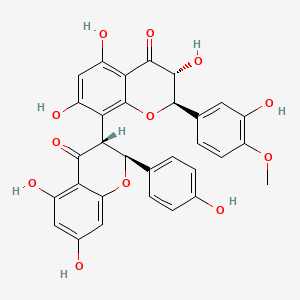
|
Kolaflavanone |
Kolaflavanone is a lipid of Polyketides (PK) class. Kolaflavanone is associated with abnormalities such as Diabetes, Hyperglycemia and Diabetic Nephropathy. The involved functions are known as Lipid Peroxidation, cholesterol biosynthetic process, Process, Excretory function and Apoptosis. Kolaflavanone often locates in Renal Tissue and Kidney - Cortex - Glomerulus (MMHCC). The associated genes with Kolaflavanone are Serum Albumin and TNF gene. The related lipids are Total cholesterol. |
125 |

|
SCHEMBL105486 |
Kakonein is a lipid of Polyketides (PK) class. Kakonein is associated with abnormalities such as Fatty Liver, Chronic liver disease, Morphologically altered structure, Hypertensive disease and Cardiovascular Diseases. The involved functions are known as protein expression, Extravasation, Liver damage, mRNA Expression and cell activation. Kakonein often locates in Body tissue, Hepatic, Microvilli, Cytoplasm and Membrane. The associated genes with Kakonein are TJP1 gene, CD14 gene, iberiotoxin, AT-Rich Interactive Domain-Containing Protein 1A and NKS1 gene. The related lipids are dehydrosoyasaponin I and Steroids. The related experimental models are Knock-out. |
1391 |

|
daidzein |
daidzein is a lipid of Polyketides (PK) class. Daidzein is associated with abnormalities such as Cardiovascular Diseases, Osteoporosis, Heart Diseases, Thyroid Diseases and Exanthema. The involved functions are known as Cell Growth, Disease Progression, metaplastic cell transformation, Cell Cycle and M Phase Cell Cycle Arrest. Daidzein often locates in Urothelium, Mucous Membrane, Chromosomes, Epithelium and Ribosomes. The associated genes with daidzein are Tumor Suppressor Genes, Genome, TIRAP gene, TICAM2 gene and Candidate Disease Gene. The related lipids are Promega, Steroids, Saponins, enterodiol and linoleates. The related experimental models are Xenograft Model, Knock-out, Mouse Model, Breast Cancer Model and Arthritis, Experimental. |
4463 |
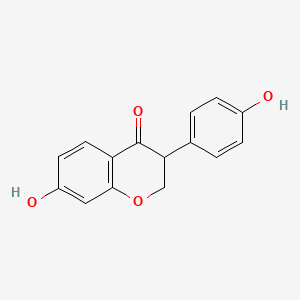
|
dihydrodaidzein |
dihydrodaidzein is a lipid of Polyketides (PK) class. Dihydrodaidzein is associated with abnormalities such as Bacteremia, Little's Disease and Postmenopausal syndrome. The involved functions are known as Metabolic Process, Cellular, racemization, Cytokinesis, enzyme mechanism and Stereochemistry. Dihydrodaidzein often locates in Cell-Free System, Face, Blood, Back and Cytoplasm. The associated genes with dihydrodaidzein are HOXA10 gene and tryptones. The related lipids are enterodiol. |
338 |
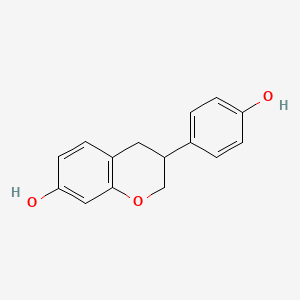
|
94105-90-5 |
94105-90-5 is a lipid of Polyketides (PK) class. 94105-90-5 is associated with abnormalities such as Fish-Eye Disease, Congenital uterine anomaly, Endometriosis, site unspecified, IMMUNE SUPPRESSION and Immune System Diseases. The involved functions are known as Anabolism, Ingestion, Signal Pathways, Phenomenon and Excretory function. 94105-90-5 often locates in brush border membrane, Entire gastrointestinal tract, Mouse Intestine, Body tissue and Skin. The associated genes with 94105-90-5 are GLUCOSIDASE, WASF1 gene, NPRL3 gene, FATE1 gene and AT-Rich Interactive Domain-Containing Protein 1A. The related lipids are butyrate, enterodiol, Steroids, Promega and Fatty Acids. The related experimental models are Mouse Model, Rodent Model, Knock-out, Disease model and Animal Disease Models. |
1223 |
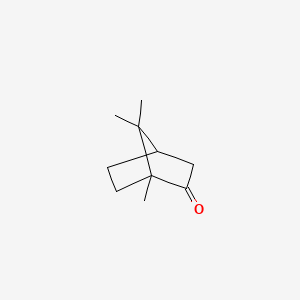
|
(+)-Camphor |
(+)-camphor is a lipid of Prenol Lipids (PR) class. (+)-camphor is associated with abnormalities such as Athetoid cerebral palsy. The involved functions are known as inhibitors, Synthesis, Feedback and Competitive inhibition. The associated genes with (+)-Camphor are 4S-limonene synthase. The related lipids are palmitoleic acid, pentadecanoic acid, stearic acid and erucic acid. |
3660 |
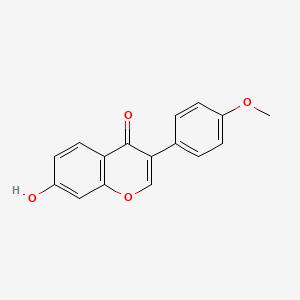
|
formononetin |
Formononetin is a lipid of Polyketides (PK) class. Formononetin is associated with abnormalities such as Infection, Dehydration, Mycoses, Consumption-archaic term for TB and Syndrome. The involved functions are known as Protein Overexpression, Methylation, Esthesia, Anabolism and enzyme activity. Formononetin often locates in soluble, Cytoplasmic matrix, Body tissue, Membrane and Tissue membrane. The associated genes with Formononetin are IMPACT gene, GLUCOSIDASE, Genes, Reporter, IGKV1-16 gene and GAL gene. The related experimental models are Knock-out. |
790 |
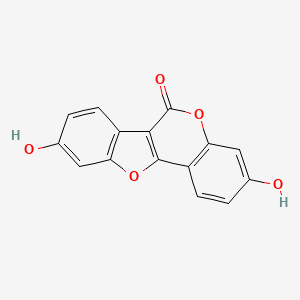
|
COUMESTROL |
COUMESTROL is a lipid of Polyketides (PK) class. Coumestrol is associated with abnormalities such as Infertility, Renal tubular disorder, Osteoporosis, Postmenopausal, Nodule and Central precocious puberty. The involved functions are known as Process, antagonists, Accident due to exposure to weather conditions, physiological aspects and Cell Proliferation. Coumestrol often locates in Blood, Body tissue, Reproductive system, Membrane and Myometrial. The associated genes with COUMESTROL are GAPDH gene, PPID gene, pyridinoline, NODAL gene and Nitrogen fixation gene. The related lipids are enterodiol. The related experimental models are Mouse Model. |
638 |
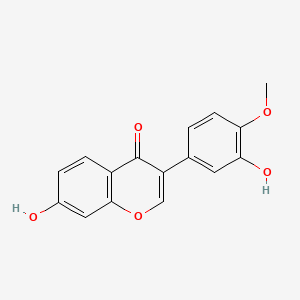
|
Calycosin |
Calycosin is a lipid of Polyketides (PK) class. Calycosin is associated with abnormalities such as Degenerative polyarthritis and Ischemia. The involved functions are known as Biosynthetic Pathways, Process, Anabolism, trans-cinnamate 4-hydroxylase activity and Transcription, Genetic. Calycosin often locates in viral nucleocapsid location, Mucous Membrane and Cell membrane. |
195 |
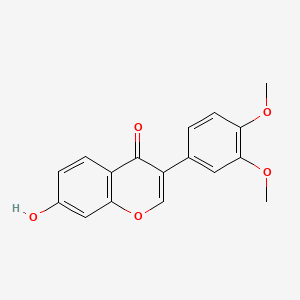
|
cladrin |
cladrin is a lipid of Polyketides (PK) class. |
9 |
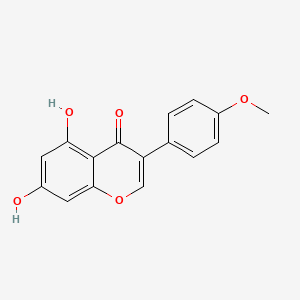
|
biochanin A |
Biochanin a is a lipid of Polyketides (PK) class. Biochanin a is associated with abnormalities such as Osteoporosis. The involved functions are known as Uptake, adenosinetriphosphatase activity, inhibitors, Drug Interactions and Metabolic Inhibition. Biochanin a often locates in Membrane, Tissue membrane, Microsomes, Microsomes, Liver and Entire oral cavity. The associated genes with Biochanin A are CD9 gene, SLCO1B1 gene, ABCG2 gene, EDNRB gene and SPAG8 gene. The related lipids are Steroids, Androstenols, Sphingolipids and 1,2-oleoylphosphatidylcholine. |
465 |

|
rotenone |
rotenone is a lipid of Polyketides (PK) class. Rotenone is associated with abnormalities such as Parkinson Disease, MYOPATHY, DISTAL, WITH ANTERIOR TIBIAL ONSET, Neurodegenerative Disorders, Septicemia and Respiratory Failure. The involved functions are known as Phosphorylation, Process, Cell Death, proteasome activity and Apoptosis. Rotenone often locates in Protoplasm, Presynaptic Terminals, Neurites, NADH dehydrogenase complex and Mitochondria. The associated genes with rotenone are DNAJB9 gene, EIF2S3 gene, Candidate Disease Gene, G-substrate and ERN1 gene. The related lipids are Lipopolysaccharides, Membrane Lipids, Phosphatidylserines, Fatty Acids and Cardiolipins. The related experimental models are Knock-out, Mouse Model, Disease model and Rodent Model. |
7079 |
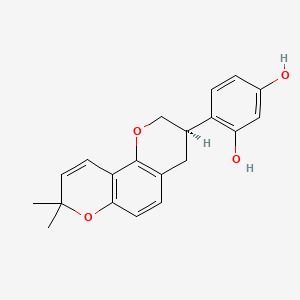
|
Glabridin |
Glabridin is a lipid of Polyketides (PK) class. Glabridin is associated with abnormalities such as Atherosclerosis, CNS disorder, Corn of toe, Fatty Liver and Obesity. The involved functions are known as Energy Absorption, Oxidation, Oxidants, Metabolic Process, Cellular and Drug Interactions. Glabridin often locates in Hepatic, membrane fraction, Microsomes, Microsomes, Liver and Extracellular. The associated genes with Glabridin are P4HTM gene, SPEN gene, SLC33A1 gene, ABCB1 gene and CD9 gene. The related lipids are Nonesterified Fatty Acids, Total cholesterol, Lipopolysaccharides, Hydroxycholesterols and 7-ketocholesterol. The related experimental models are Mouse Model. |
263 |

|
HEMATOXYLIN |
HEMATOXYLIN is a lipid of Polyketides (PK) class. Hematoxylin is associated with abnormalities such as Eosinophilia, Duodenal Adenoma, Senile Plaques, Morphologically altered structure and Cervical abscess. The involved functions are known as Uptake, Apoptosis, Amplification, Necrosis and Karyopyknosis. Hematoxylin often locates in Body tissue, Extracellular, Compact bone, Skin and Basement membrane. The associated genes with HEMATOXYLIN are GAPDH gene, Genome, Elastin, MERTK wt Allele and P4HTM gene. |
6127 |
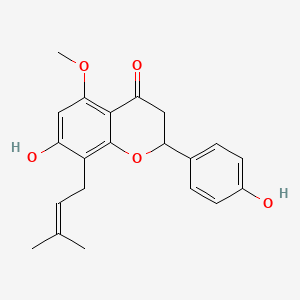
|
Isoxanthohumol |
Isoxanthohumol is a lipid of Polyketides (PK) class. |
59 |
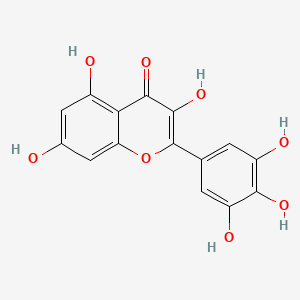
|
myricetin |
myricetin is a lipid of Polyketides (PK) class. Myricetin is associated with abnormalities such as Diabetes, First myocardial infarction, Diabetes Mellitus, Non-Insulin-Dependent, Asthma and Cataract. The involved functions are known as Cell Survival, inhibitors, Process, Metabolic Inhibition and Oxidation. Myricetin often locates in Fibril - cell component, soluble, Body tissue, Back and Tissue membrane. The associated genes with myricetin are HPGDS gene, P4HTM gene, CFLAR gene, SLC2A2 gene and SLC2A1 gene. The related lipids are Promega, Sterols, dipalmitoylphosphatidylserine, 1,2-oleoylphosphatidylcholine and Membrane Lipids. |
1801 |
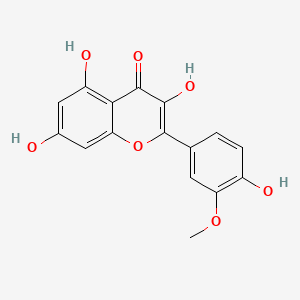
|
Isorhamnetin |
Isorhamnetin is a lipid of Polyketides (PK) class. Isorhamnetin is associated with abnormalities such as Facial Hemiatrophy, Colitis, endothelial dysfunction, Morphologically altered structure and Diabetes. The involved functions are known as enzyme activity, Methylation, Anabolism, Binding (Molecular Function) and Vmax. Isorhamnetin often locates in Body tissue, Cytoplasmic, Mucous Membrane, Cytoplasm and Human tissue. The associated genes with Isorhamnetin are CSK gene, RPS6KA3 gene, Mitogen-activated protein, NCF1 gene and Chromatin. The related lipids are Fatty Acids, Phosphatidylserines and Palmitates. The related experimental models are Mouse Model, Xenograft Model and Streptozotocin Diabetes. |
1015 |
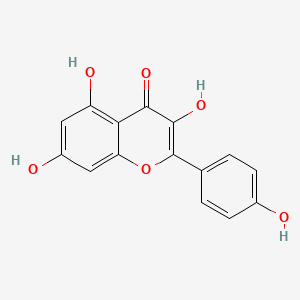
|
kaempferol |
kaempferol is a lipid of Polyketides (PK) class. Kaempferol is associated with abnormalities such as Cardiovascular Diseases, IMMUNE SUPPRESSION, Inflammatory disorder, Dermatitis, Atopic and Asthma. The involved functions are known as enzyme activity, antagonists, DNA Binding, Anabolism and Transcription, Genetic. Kaempferol often locates in aryl hydrocarbon receptor complex, Cytoplasmic matrix, soluble, BL21 and Vacuole. The associated genes with kaempferol are CYP1A1 gene, AHR gene, Genes, Reporter, Candidate Disease Gene and Alleles. The related lipids are Fatty Acids, Steroids, Lipopolysaccharides, Total cholesterol and Palmitates. The related experimental models are Knock-out, Xenograft Model, Breast Cancer Model, Disease model and Animal Disease Models. |
3675 |

|
quercetin |
quercetin is a lipid of Polyketides (PK) class. Quercetin is associated with abnormalities such as Coronary heart disease, Myocardial Infarction, Cirrhosis, Coronary Arteriosclerosis and Vascular ring. The involved functions are known as Vasodilation, physiological aspects, Fermentation, Process and Ingredient. Quercetin often locates in Arterial system, Endothelium, Skin, Endothelium, Vascular and Tissue specimen. The associated genes with quercetin are P4HTM gene, SULT gene, UGT1A1 gene, ARHGAP26 gene and PLXNB1 gene. The related lipids are blood lipid, Promega, Steroids, Phosphatidylserines and Fatty Acids. The related experimental models are Knock-out, Mouse Model, Xenograft Model, Tissue Model and Cancer Model. |
5377 |

|
apigenin |
apigenin is a lipid of Polyketides (PK) class. Apigenin is associated with abnormalities such as Morphologically altered structure, Chimera disorder, Hypertensive disease, infection induced and Infection. The involved functions are known as inhibitors, Gene Expression, Process, Metabolic Inhibition and Cell Death. Apigenin often locates in Vacuole, Cytoplasmic matrix, Cytoplasm, Tissue membrane and Membrane. The associated genes with apigenin are MSMP gene, BCL2 gene, PTGS2 gene, Chromatin and SLC33A1 gene. The related lipids are Lipopolysaccharides, Steroids, 1-Butanol, agosterol A and Butyrates. The related experimental models are Mouse Model, Tissue Model, Knock-out, Xenograft Model and Disease model. |
4250 |

|
luteolin |
luteolin is a lipid of Polyketides (PK) class. Luteolin is associated with abnormalities such as Morphologically altered structure, Nodule, retinal toxicity, CLEFT LIP, CONGENITAL HEALED and Ischemia. The involved functions are known as Metabolic Inhibition, Cell Death, Caspase Activation, activation of protein kinase C activity by G-protein coupled receptor protein signaling pathway and protein kinase C activity. Luteolin often locates in Mitochondria, Cell-Free System, Protoplasm, Membrane and Body tissue. The associated genes with luteolin are BCL2 gene, TNFSF10 gene, BCL2L1 gene, XIAP gene and MCL1 gene. The related lipids are Lipopolysaccharides, Sterols, blood lipid, Fatty Acids and Steroids. The related experimental models are Xenograft Model, Mouse Model, Experimental Autoimmune Encephalomyelitis, Knock-out and Cancer Model. |
3284 |
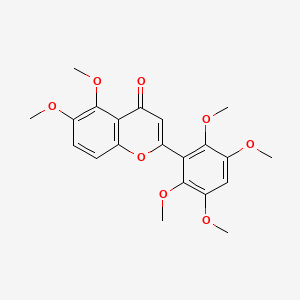
|
5,6,2',3',5',6'-Hexamethoxyflavone |
5,6,2',3',5',6'-Hexamethoxyflavone is a lipid of Polyketides (PK) class. |
14 |

|
FLAVONE |
FLAVONE is a lipid of Polyketides (PK) class. Flavone is associated with abnormalities such as Cardiovascular Diseases, Cerebrovascular accident, DERMATITIS HERPETIFORMIS, FAMILIAL, Hyperinsulinism and Inflammatory disorder. The involved functions are known as Oxidation-Reduction, Metabolic Inhibition, Inflammation, Phosphorylation and antioxidant activity. Flavone often locates in Endothelium, Hepatic, Protoplasm, Body tissue and Extracellular. The associated genes with FLAVONE are ICAM1 gene, BCL2L1 gene, MYC gene, TP53 gene and cytochrome c''. The related lipids are Promega, Steroids and Total cholesterol. The related experimental models are Knock-out, Disease model and Animal Disease Models. |
2093 |
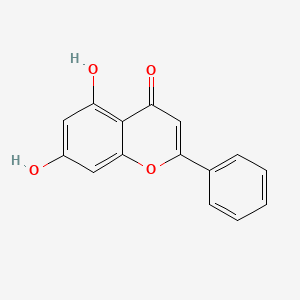
|
chrysin |
chrysin is a lipid of Polyketides (PK) class. Chrysin is associated with abnormalities such as Unconjugated hyperbilirubinemia, Metabolic Diseases, Hypogonadism, Renal tubular disorder and Colitis. The involved functions are known as Hypoxia, enzyme activity, Oxidation, inhibitors and Cell Survival. Chrysin often locates in Protoplasm, Plasma membrane, Back, Extracellular and Mitochondria. The associated genes with chrysin are CFB gene, P4HTM gene, UGT1A9 gene, CYP1A1 gene and UGT1A1 gene. The related lipids are Promega, estradiol-3-glucuronide, Steroids and Lipopolysaccharides. The related experimental models are Mouse Model. |
1085 |
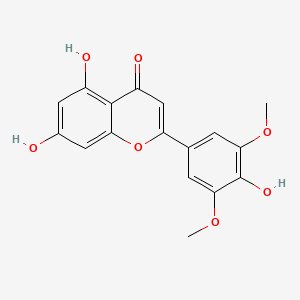
|
Tricin |
Tricin is a lipid of Polyketides (PK) class. Tricin is associated with abnormalities such as Consumption-archaic term for TB, Hyperostosis, Diffuse Idiopathic Skeletal, Intestinal Polyps, polyps and Enzyme inhibition disorder. The involved functions are known as Anabolism, enzyme activity, peroxidase activity, Pharmacodynamics and protein expression. Tricin often locates in Small intestine mucous membrane, Blood, Intestinal Mucosa, Body tissue and Skeletal system. The related lipids are 3-hydroxycholest-7-ene-14-carbaldehyde. The related experimental models are Mouse Model. |
193 |

|
baicalein |
baicalein is a lipid of Polyketides (PK) class. Baicalein is associated with abnormalities such as Neurodegenerative Disorders, Fibrillation, Hypertensive disease, Aortic coarctation and Coronary Occlusion. The involved functions are known as Anabolism, Polymerization, Process, inhibitors and Pathogenesis. Baicalein often locates in Membrane, Lipid Bilayers, soluble, Cell-Free System and Protoplasm. The associated genes with baicalein are P4HTM gene, BIRC5 gene, TSPO gene, SHOC2 gene and XIAP gene. The related lipids are Fatty Acids, Nonesterified Fatty Acids, iodoresiniferatoxin, Lipopolysaccharides and 17-octadecynoic acid. The related experimental models are Knock-out, Mouse Model and Parkinsonism, Experimental. |
1997 |
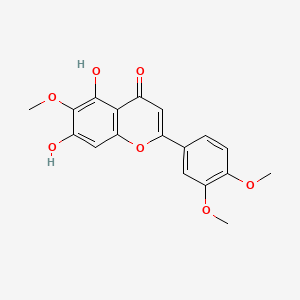
|
Eupatilin |
Eupatilin is a lipid of Polyketides (PK) class. |
124 |

|
Wogonin |
Wogonin is a lipid of Polyketides (PK) class. Wogonin is associated with abnormalities such as Hyperlipidemia, Atherosclerosis, Inflammatory disorder, Dermatitis, Atopic and Ischemia. The involved functions are known as Inflammation, Regulation, luciferase activity, store-operated calcium entry and Transcriptional Activation. Wogonin often locates in Cytoplasmic matrix, Pore, Membrane, Protoplasm and Mitochondria. The associated genes with Wogonin are SGK1 gene, ORAI1 gene, STIM1 gene, P4HTM gene and BCL2 gene. |
732 |
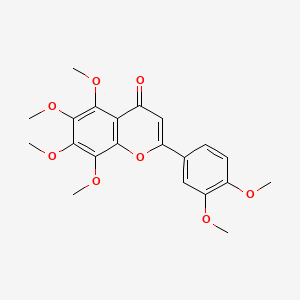
|
Nobiletin |
Nobiletin is a lipid of Polyketides (PK) class. Nobiletin is associated with abnormalities such as Hashimoto Disease, nervous system disorder, Dermatitis, Senile Plaques and Metabolic Diseases. The involved functions are known as 5-(carboxyamino)imidazole ribonucleotide mutase activity, Signal Transduction, Biochemical Pathway, Phosphorylation and MAP kinase kinase activity. Nobiletin often locates in Extracellular, Protoplasm, Back, Mouse Skin and Skin - Epidermis (MMHCC). The associated genes with Nobiletin are MAP2K1 gene, PTGS2 gene, Amyloid beta-Protein Precursor, Candidate Disease Gene and BCL2 gene. The related lipids are Lipopolysaccharides and Sterols. The related experimental models are Mouse Model and Transgenic Model. |
550 |
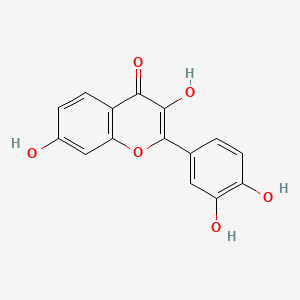
|
Fisetin |
Fisetin is a lipid of Polyketides (PK) class. Fisetin is associated with abnormalities such as Morphologically altered structure, PARKINSON DISEASE, LATE-ONSET, Tetanus, CNS disorder and Disintegration (morphologic abnormality). The involved functions are known as Autophagy, Apoptosis, Energy Metabolism, Acceleration and Anabolism. Fisetin often locates in Mitochondria, Cytoplasmic matrix, Extracellular, Cytoskeletal Filaments and Autophagic vacuole. The associated genes with Fisetin are SIRT1 gene, MAP1LC3A gene, TP53 gene, P4HTM gene and AURKB gene. The related lipids are Phosphatidylserines and Lipopolysaccharides. The related experimental models are Animal Cancer Model, Xenograft Model, Mouse Model, Cancer Model and Disease model. |
832 |

|
Galangin |
Galangin is a lipid of Polyketides (PK) class. Galangin is associated with abnormalities such as Morphologically altered structure and Wiskott-Aldrich Syndrome. The involved functions are known as Apoptosis, Metabolic Inhibition, Cell Proliferation, Process and Proliferation (morphologic abnormality). Galangin often locates in Microsomes, Liver, Cytoplasmic matrix, Microsomes, Protoplasm and Tissue membrane. The associated genes with Galangin are CYP1A1 gene, CYP1A2 gene, WNT3A gene, ALPP gene and TCF7L2 gene. The related lipids are Promega. |
491 |
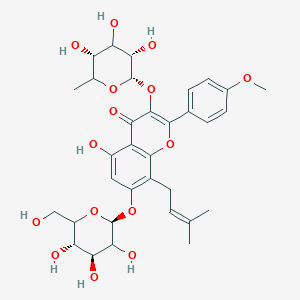
|
LMPK12112009 |
LMPK12112009 is a lipid of Polyketides (PK) class. |
216 |
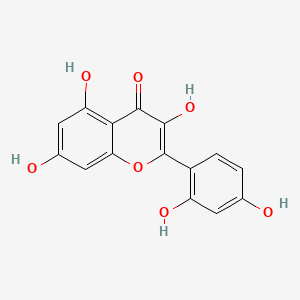
|
morin |
morin is a lipid of Polyketides (PK) class. Morin is associated with abnormalities such as Colitis, Hyperuricemia, Gout, Parkinson Disease and Rheumatoid Arthritis. The involved functions are known as establishment and maintenance of localization, Binding (Molecular Function), Uptake, Increased Sensitivy and Cell Cycle Arrest. Morin often locates in Cell Wall, apoplast, Plasma membrane, Cytoplasmic matrix and Membrane. The associated genes with morin are GADD45A gene, MAPK8 gene, ODAM gene, TNFRSF1A gene and ALPP gene. The related lipids are Lipopolysaccharides, Butyrates, Fatty Acids, Nonesterified, Palmitates and Oleates. |
1499 |
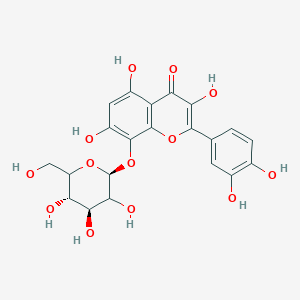
|
Gossypetin 8-glucoside |
Gossypetin 8-glucoside is a lipid of Polyketides (PK) class. Gossypetin 8-glucoside is associated with abnormalities such as skin toxicity. The involved functions are known as Angiogenic Process, antioxidant activity and Inflammation. |
38 |
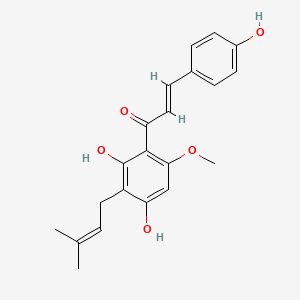
|
Xanthohumol |
Xanthohumol is a lipid of Polyketides (PK) class. Xanthohumol is associated with abnormalities such as Endometriosis, site unspecified, Cyst, peritoneal lesion, Proliferative inflammation and furuncle. The involved functions are known as Cell Proliferation, Signal Transduction, Pathologic Neovascularization, Adverse effects and Proliferation (morphologic abnormality). Xanthohumol often locates in peritoneal, Mesentery, Membrane, Tissue specimen from uterus and Cell Nucleus. The associated genes with Xanthohumol are PI3 gene, KEAP1 gene, SLC33A1 gene, BCR-ABL Fusion Gene and BIRC5 gene. The related lipids are Fatty Acids and Palmitates. The related experimental models are Knock-out. |
465 |
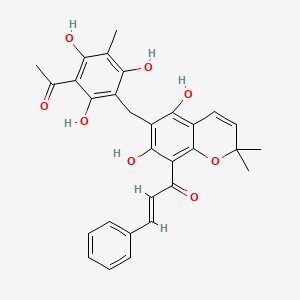
|
rottlerin |
Rottlerin is a lipid of Polyketides (PK) class. Rottlerin is associated with abnormalities such as PARAGANGLIOMAS 2, Hyperostosis, Diffuse Idiopathic Skeletal, Virus Diseases, Perisylvian syndrome and Autoimmune disease (systemic) NOS. The involved functions are known as Apoptosis, Regulation, Signal Transduction, inhibitors and Proteasome Inhibitors [MoA]. Rottlerin often locates in Clone, Membrane, Body tissue, Plasma membrane and soluble. The associated genes with Rottlerin are XIAP gene, GAPDH gene, ICAM1 gene, P4HTM gene and TNFSF10 gene. The related lipids are Promega, Fatty Acids, Sphingolipids, Lipopolysaccharides and Saponin. The related experimental models are Mouse Model, Xenograft Model and Cancer Model. |
1198 |
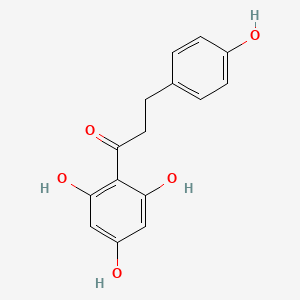
|
phloretin |
phloretin is a lipid of Polyketides (PK) class. Phloretin is associated with abnormalities such as Atherosclerosis, Diabetes Mellitus, Non-Insulin-Dependent, Alkalemia, Renal tubular disorder and pathologic fistula. The involved functions are known as Anabolism, glycosyltransferase activity, Biosynthetic Pathways, Localized desquamation and Biological Processes. Phloretin often locates in soluble, BL21, Cytoplasmic, Extracellular and Cytoplasm. The associated genes with phloretin are Homologous Gene, CD36 gene, Candidate Disease Gene, SLC33A1 gene and PAK1IP1 gene. The related lipids are Liposomes, Palmitates, Fatty Acids, Sterols and 6-ketocholestanol. The related experimental models are Knock-out. |
2367 |

|
naringenin |
naringenin is a lipid of Polyketides (PK) class. Naringenin is associated with abnormalities such as Dehydration, Papillon-Lefevre Disease, BOSLEY-SALIH-ALORAINY SYNDROME, Cardiovascular Diseases and Atherosclerosis. The involved functions are known as Pigmentation, Biosynthetic Pathways, metaplastic cell transformation, 4-coumarate-CoA ligase activity and Pigment. Naringenin often locates in Body tissue, Cell Wall, Membrane, Cytoplasmic matrix and Tissue membrane. The associated genes with naringenin are Genome, Genes, Regulator, Alleles, Homologous Gene and SPEN gene. The related lipids are Fatty Acids, Total cholesterol, Lipopolysaccharides, Oleates and Cholesterol, Dietary. The related experimental models are Knock-out and Mouse Model. |
2420 |
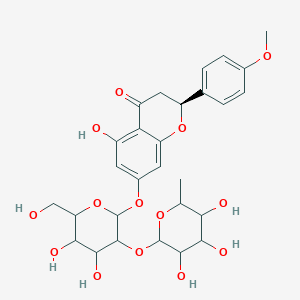
|
Poncirin |
Poncirin is a lipid of Polyketides (PK) class. |
53 |
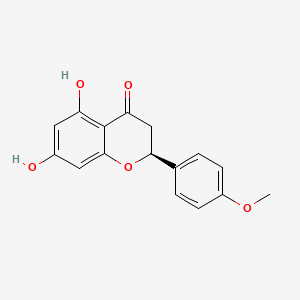
|
Isosakuranetin |
Isosakuranetin is a lipid of Polyketides (PK) class. |
49 |
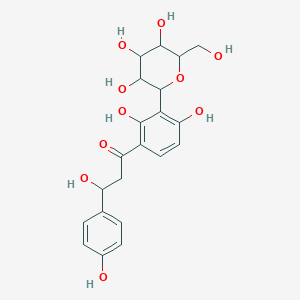
|
Pterosupin |
Pterosupin is a lipid of Polyketides (PK) class. |
8 |
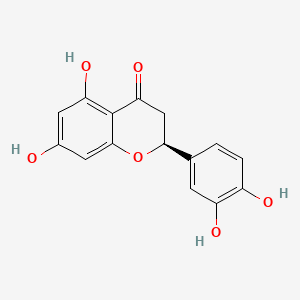
|
ERIODICTYOL |
Eriodictyol is a lipid of Polyketides (PK) class. Eriodictyol is associated with abnormalities such as Hyperostosis, Diffuse Idiopathic Skeletal, Macular degeneration, Consumption-archaic term for TB, Retinal Diseases and PARAGANGLIOMAS 4. The involved functions are known as glutathione biosynthetic process, Cytoprotection, Oxidants, protein expression and Cell Survival. Eriodictyol often locates in Cytoplasmic matrix, Protoplasm, Cytoplasmic, Cell Fraction and Back. The associated genes with Eriodictyol are NQO, HMOX1 gene, IMPACT gene, RPS6KA3 gene and GDNF gene. |
311 |
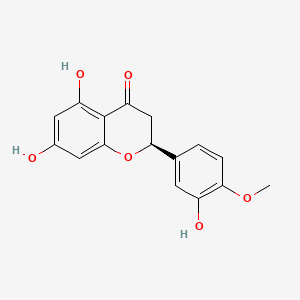
|
hesperetin |
Hesperetin is a lipid of Polyketides (PK) class. Hesperetin is associated with abnormalities such as Corn of toe, Ischemia, Osteoporosis, Consumption-archaic term for TB and Wiskott-Aldrich Syndrome. The involved functions are known as conjugation, inhibitors, Process, mRNA Expression and Adjudication. Hesperetin often locates in Entire intestinal epithelium, Protoplasm, Membrane, Shoulder and Back. The associated genes with Hesperetin are ABCG2 gene, ABCC2 gene, FATE1 gene, ABCB1 gene and P-glycoprotein 2. |
801 |
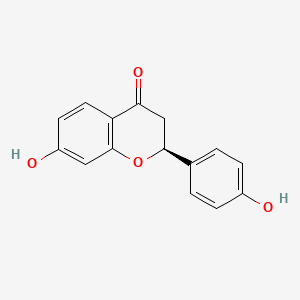
|
Liquiritigenin |
Liquiritigenin is a lipid of Polyketides (PK) class. Liquiritigenin is associated with abnormalities such as POSTMENOPAUSAL SYNDROME, Hyperostosis, Diffuse Idiopathic Skeletal, PARAGANGLIOMAS 2, Wiskott-Aldrich Syndrome and Alzheimer's Disease. The involved functions are known as Heterodimerization, Transcription, Genetic, Ligand Binding, Transcriptional Activation and Anabolism. Liquiritigenin often locates in Membrane, Blood, Microsomes, Liver, Microsomes and Body tissue. The associated genes with Liquiritigenin are Candidate Disease Gene, IMPACT gene, TNFSF10 gene, SLC33A1 gene and P4HTM gene. The related lipids are Lipopolysaccharides, pregnenolone sulfate and FuGene. The related experimental models are Xenograft Model. |
313 |
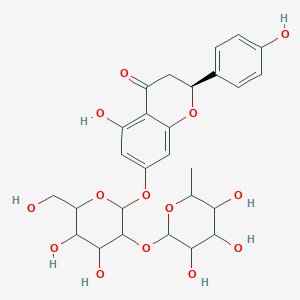
|
NSC5548 |
NSC5548 is a lipid of Polyketides (PK) class. Nsc5548 is associated with abnormalities such as Diabetes Mellitus, Non-Insulin-Dependent, Hyperglycemia, Coronary Arteriosclerosis, Liver diseases and Pulmonary Edema. The involved functions are known as Increased Sensitivy, Taste Perception, Cell Death, Phosphorylation and Signal Transduction. Nsc5548 often locates in Oral region, Cytoskeleton, Hepatic, Blood and Mouse Bone Marrow. The associated genes with NSC5548 are CA2 gene, P4HTM gene, FPGT gene, glycyl-L-phenylalanine and glycylphenylalanine. The related lipids are butyrate, Lipid Peroxides, blood lipid, Sterols and Total cholesterol. |
283 |
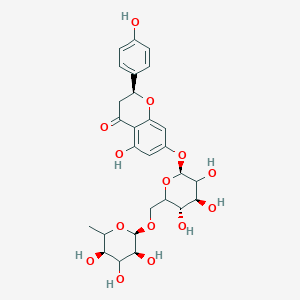
|
LMPK12140236 |
LMPK12140236 is a lipid of Polyketides (PK) class. |
8 |

|
hesperidin |
(2S)-5-hydroxy-2-(3-hydroxy-4-methoxyphenyl)-4-oxo-3,4-dihydro-2H-chromen-7-yl 6-O-(6-deoxyhexopyranosyl)hexopyranoside is a lipid of Polyketides (PK) class. (2s)-5-hydroxy-2-(3-hydroxy-4-methoxyphenyl)-4-oxo-3,4-dihydro-2h-chromen-7-yl 6-o-(6-deoxyhexopyranosyl)hexopyranoside is associated with abnormalities such as Osteoporosis, Postmenopausal, estrogen deficiency, Chronic venous insufficiency, Neurodegenerative Disorders and Cerebrovascular accident. The involved functions are known as Sweetening Agents, Vmax, enzyme activity, Fermentation and Regulation. (2s)-5-hydroxy-2-(3-hydroxy-4-methoxyphenyl)-4-oxo-3,4-dihydro-2h-chromen-7-yl 6-o-(6-deoxyhexopyranosyl)hexopyranoside often locates in Entire gastrointestinal tract, soluble, Entire bony skeleton, Trabecular substance of bone and Blood. The associated genes with (2S)-5-hydroxy-2-(3-hydroxy-4-methoxyphenyl)-4-oxo-3,4-dihydro-2H-chromen-7-yl 6-O-(6-deoxyhexopyranosyl)hexopyranoside are MTPN gene, GLUCOSIDASE, STN gene, SLC33A1 gene and GHRL gene. The related lipids are Total cholesterol and blood lipid. The related experimental models are Arthritis, Collagen-Induced. |
1455 |
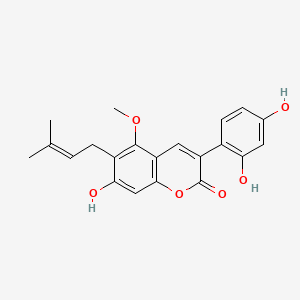
|
Glycycoumarin |
Glycycoumarin is a lipid of Polyketides (PK) class. Glycycoumarin is associated with abnormalities such as Hypertensive disease and Hyperglycemia. The involved functions are known as Ligand Binding, Peroxisome Proliferator-activated Receptor Activity [MoA] and peroxisome proliferator activated receptor binding. Glycycoumarin often locates in Blood, Mesentery, Adipose tissue and Entire nose, accessory sinus and nasopharynx, CS. |
36 |
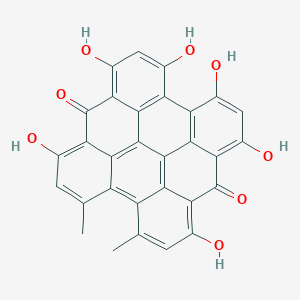
|
hypericin |
hypericin is a lipid of Polyketides (PK) class. Hypericin is associated with abnormalities such as Dermatitis, Phototoxic, Dehydration, Photosensitization, Morphologically altered structure and Myocardial Infarction. The involved functions are known as Cell Cycle Checkpoints, Apoptosis, Acetylation, Cell Survival and Caspase Activation. Hypericin often locates in insoluble fraction, Cytoplasmic matrix, Protoplasm, Tissue membrane and Cytoplasm. The associated genes with hypericin are CDC37 gene, HSPA8 gene, RAF1 gene, cyclin H and FK228. The related lipids are Phosphatidylserines. |
1752 |

|
emodin |
emodin is a lipid of Polyketides (PK) class. Emodin is associated with abnormalities such as Infection, Conjunctivitis, Vernal, Stevens-Johnson Syndrome, Conjunctival scar and Allergic Conjunctivitis. The involved functions are known as signaling cascade, Metabolic Inhibition, Cell Death, Phosphorylation and JNK Pathway. Emodin often locates in Membrane, Protoplasm, Mitochondria, Cytoplasmic matrix and soluble. The associated genes with emodin are cytochrome c'', UTS2 gene, TK Gene, Gene Clusters and CFC1 gene. The related lipids are Phosphatidylserines, Promega, Sphingolipids, Membrane Lipids and Palmitates. The related experimental models are Mouse Model and Transgenic Model. |
1742 |
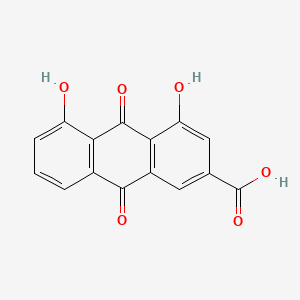
|
Rhein |
Rhein is a lipid of Polyketides (PK) class. Rhein is associated with abnormalities such as Obesity, Non-alcoholic Fatty Liver Disease, Dyslipidemias, Fatty Liver and Degenerative polyarthritis. The involved functions are known as Adipogenesis, Insulin Resistance, luciferase activity, Transcription, Genetic and Inflammation. Rhein often locates in Hepatic, Brown Fat, Muscle, Mouse Liver and Mitochondria. The associated genes with Rhein are QRSL1 gene, Candidate Disease Gene, CFB gene, STAT6 gene and GATA3 gene. The related lipids are Fatty Acids. |
986 |

|
doxorubicin |
Adriamycin is a lipid of Polyketides (PK) class. Adriamycin is associated with abnormalities such as Cardiomyopathies. The involved functions are known as Transcription, Genetic, Process, Drug effect disorder, Diastasis and Oxidation-Reduction. Adriamycin often locates in Muscle, Myocardium and Entire gastrointestinal tract. |
54913 |
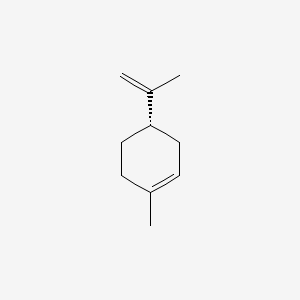
|
(-)-Limonene |
(-)-limonene is a lipid of Prenol Lipids (PR) class. (-)-limonene often locates in Kinetochores. |
1786 |

|
(-)-Perillyl alcohol |
(-)-perillyl alcohol is a lipid of Prenol Lipids (PR) class. The involved functions are known as Cell Cycle Progression, Cell Cycle, Cell Proliferation, Apoptosis and Isoprenylation. (-)-perillyl alcohol often locates in Cytoplasm, Membrane and Plasma membrane. The associated genes with (-)-Perillyl alcohol are JUN gene, Candidate Disease Gene, IL24 gene, BCL2L1 gene and CFB gene. The related experimental models are Transgenic Model. |
299 |
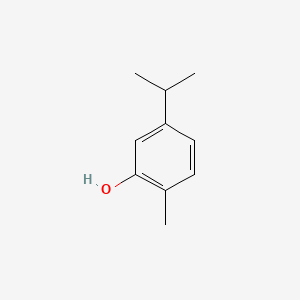
|
Carvacrol |
Carvacrol is a lipid of Prenol Lipids (PR) class. Carvacrol is associated with abnormalities such as Consumption-archaic term for TB, Disintegration (morphologic abnormality), Infection, Corn of toe and Candidiasis of vagina. The involved functions are known as Stereochemistry, Anabolism, Oxidation, Process and Binding (Molecular Function). Carvacrol often locates in Skin, Nerve Tissue, Membrane, Endothelium and Plasma membrane. The associated genes with Carvacrol are P4HTM gene, TRPV3 gene, TRPV1 gene, TRPV2 gene and TRPV4 gene. The related lipids are Fatty Acids, Lipopolysaccharides, Octanols, Micelles and butyrate. |
1535 |
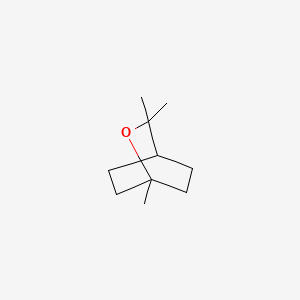
|
1,8-Cineol |
1,8-cineol is a lipid of Prenol Lipids (PR) class. The involved functions are known as Amplification, enzyme activity and inhibitors. 1,8-cineol often locates in subsynaptic reticulum. The related lipids are palmitoleic acid, pentadecanoic acid, stearic acid and erucic acid. |
1326 |
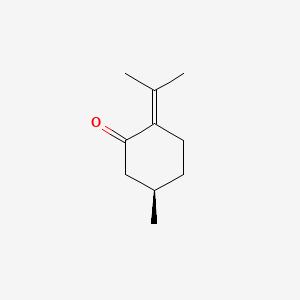
|
(+)-Pulegone |
(+)-pulegone is a lipid of Prenol Lipids (PR) class. The involved functions are known as Excretory function, conjugation, Competitive inhibition, radiochemical and Synthesis. (+)-pulegone often locates in Microsomes. The associated genes with (+)-Pulegone are 4S-limonene synthase. |
296 |

|
Alpha-terpinene |
Alpha-terpinene is a lipid of Prenol Lipids (PR) class. |
258 |
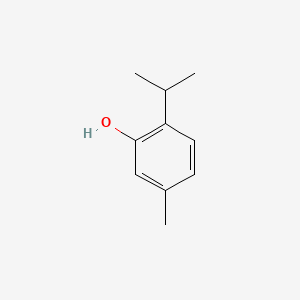
|
Thymol |
Thymol is a lipid of Prenol Lipids (PR) class. Thymol is associated with abnormalities such as Anemia, end organ damage, Dental caries, CLEFT LIP, CONGENITAL HEALED and Wiskott-Aldrich Syndrome. The involved functions are known as synergism, antagonists, Metabolic Inhibition, Pressure- physical agent and Drug Interactions. Thymol often locates in Mucous Membrane, apical membrane, Protoplasm, Extracellular and Serosal. The associated genes with Thymol are HIST1H1C gene, TRPA1 gene, MERTK wt Allele, SLC12A2 gene and TRPV3 gene. The related lipids are Propionate, Pinene, palmitoleic acid, pentadecanoic acid and stearic acid. |
3008 |
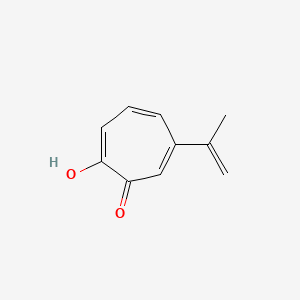
|
Beta-dolabrin |
Beta-dolabrin is a lipid of Prenol Lipids (PR) class. |
10 |
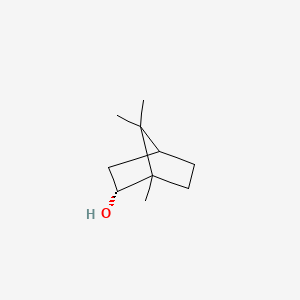
|
(-)-Borneol |
(-)-borneol is a lipid of Prenol Lipids (PR) class. The involved functions are known as Protein-Protein Interaction. |
355 |
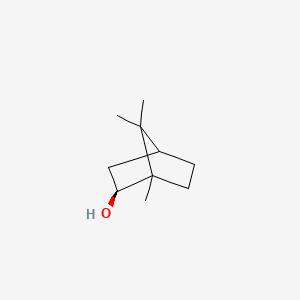
|
(+)-borneol |
(+)-borneol is a lipid of Prenol Lipids (PR) class. |
211 |

|
Camphorquinone |
Camphorquinone is a lipid of Prenol Lipids (PR) class. The involved functions are known as Polymerization. The related lipids are camphoroquinone. |
385 |
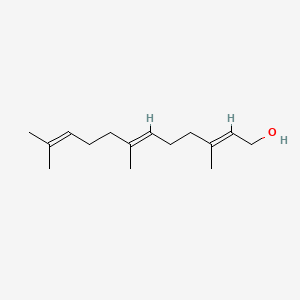
|
2E,6E-farnesol |
2e,6e-farnesol is a lipid of Prenol Lipids (PR) class. 2e,6e-farnesol is associated with abnormalities such as Granulomatous Disease, Chronic, pathologic fistula and Cavitation. The involved functions are known as Regulation, Metabolic Inhibition, cholesterol biosynthetic process, Process and Transcription, Genetic. 2e,6e-farnesol often locates in Plasma membrane, Cytoplasmic matrix, cornified envelope, Epidermis and peroxisome. The associated genes with 2E,6E-farnesol are RAB3A gene, FOSL1 gene, CASP8AP2 gene, RCC1 gene and GALE gene. The related lipids are Sterols, Membrane Lipids and Steroids. |
1905 |
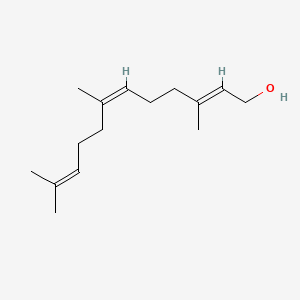
|
(e,z)-farnesol |
(e,z)-farnesol is a lipid of Prenol Lipids (PR) class. |
1183 |
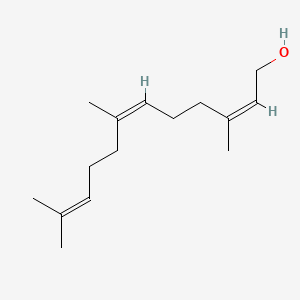
|
(z,z)-farnesol |
(z,z)-farnesol is a lipid of Prenol Lipids (PR) class. |
1183 |
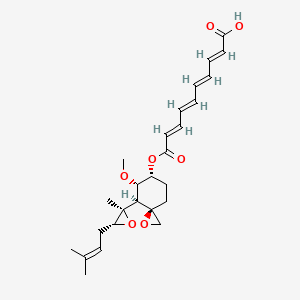
|
fumagillin |
Fumagillin is a lipid of Prenol Lipids (PR) class. Fumagillin is associated with abnormalities such as Atherosclerosis, Dentatorubral-Pallidoluysian Atrophy, Severe Combined Immunodeficiency, Immunologic Deficiency Syndromes and Arthritis. The involved functions are known as Gene Expression, Apoptosis, Angiogenic Process, Infiltration and Adverse effects. Fumagillin often locates in Endothelium, Body tissue, Blood, soluble and Protoplasm. The associated genes with fumagillin are HIST1H1C gene, RAC1 gene, c-myb Genes, METAP2 gene and NCKIPSD gene. The related lipids are helvolic acid, Butyrates and Butanols. The related experimental models are Mouse Model, Xenograft Model and Cancer Model. |
500 |
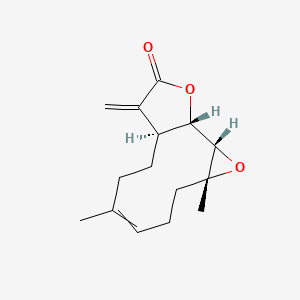
|
Parthenolide |
Parthenolide is a lipid of Prenol Lipids (PR) class. Parthenolide is associated with abnormalities such as Migraine Disorders, abnormal fragmented structure, Hyperostosis, Diffuse Idiopathic Skeletal, Consumption-archaic term for TB and Infection. The involved functions are known as Apoptosis, Cell Proliferation, Inflammation, pathologic cytolysis and Membrane Potentials. Parthenolide often locates in Mitochondria, Tissue membrane, Cytoplasmic matrix, Cytoplasm and Body tissue. The associated genes with Parthenolide are IGKJ1 gene, BCL2 gene, DDIT3 gene, Procaspase 7 and GAPDH gene. The related lipids are A(2)C. The related experimental models are Mouse Model, Xenograft Model, Breast Cancer Model and Cancer Model. |
925 |
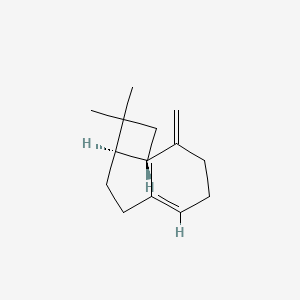
|
beta-Caryophyllene |
Beta-caryophyllene is a lipid of Prenol Lipids (PR) class. Beta-caryophyllene is associated with abnormalities such as Atherosclerosis. The involved functions are known as dose-response relationship. Beta-caryophyllene often locates in extrinsic to membrane. |
573 |

|
Gossypol |
Gossypol is a lipid of Prenol Lipids (PR) class. Gossypol is associated with abnormalities such as Paralytic Ileus, PARKINSON DISEASE, LATE-ONSET, Fibrillation, Hepatic necrosis and Lymphopenia. The involved functions are known as Atrophic, Ulcer, Necrosis, Apoptosis and antagonists. Gossypol often locates in Mucous Membrane, Epithelium, Blood, Microsomes, Liver and Autophagic vacuole. The associated genes with Gossypol are BCL2A1 gene, BCL2 gene, Transgenes, IGH@ gene cluster and Bax protein (53-86). The related lipids are Promega, proteoliposomes, Phosphatidylserines and Liposomes. The related experimental models are Transgenic Model and Xenograft Model. |
2557 |

|
Thapsigargin |
Thapsigargin is a lipid of Prenol Lipids (PR) class. Thapsigargin is associated with abnormalities such as Impaired glucose tolerance, Obesity and Blood Pressure Disorders. The involved functions are known as Phosphorylation, establishment and maintenance of localization, Regulation, Metabolic Inhibition and Proteolysis. Thapsigargin often locates in Mouse Skin, Cytoplasm, Skin, Protoplasm and Mitochondria. The associated genes with Thapsigargin are ERBB4 gene, F11 gene, CA1 gene, TRNAP1 gene and HSPA5 gene. The related lipids are taurolithocholic acid 3-sulfate, Liposomes, Fatty Acids and stearylamine. The related experimental models are Mouse Model. |
8868 |
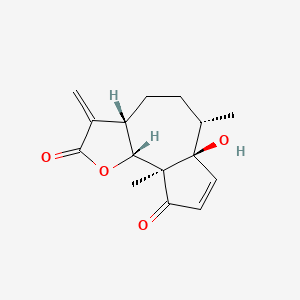
|
Parthenin |
Parthenin is a lipid of Prenol Lipids (PR) class. Parthenin is associated with abnormalities such as Plasmodium falciparum infection. The involved functions are known as Diastasis, Lipid Peroxidation, cell invasion, male gametophyte development and DNA biosynthesis. Parthenin often locates in Blood and Flagella. |
67 |
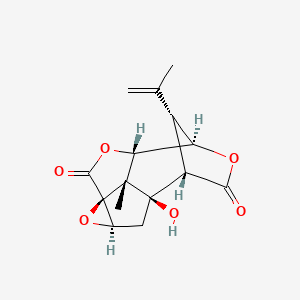
|
(-)-Picrotoxinin |
(-)-picrotoxinin is a lipid of Prenol Lipids (PR) class. |
246 |
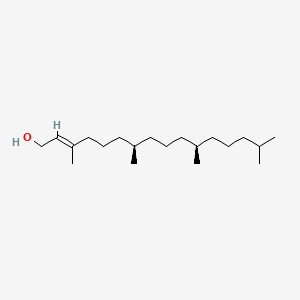
|
Phytol |
Phytol is a lipid of Prenol Lipids (PR) class. Phytol is associated with abnormalities such as Simian Acquired Immunodeficiency Syndrome, Hypoglycemia, Refsum Disease, Peripheral Neuropathy and Metabolic Diseases. The involved functions are known as Oxidation, transmethylation, fatty acid oxidation, Lipid Metabolism and chlorophyll catabolic process. Phytol often locates in Mitochondria, Membrane, peroxisome, Cytoplasm and Body tissue. The associated genes with Phytol are ETFDH gene, Homologous Gene, Genome, IMPACT gene and Arabidopsis Proteins. The related lipids are Fatty Acids, Nonesterified Fatty Acids, nonadecanoic acid, branched chain fatty acid and pristanic acid. The related experimental models are Mouse Model. |
411 |



































































































